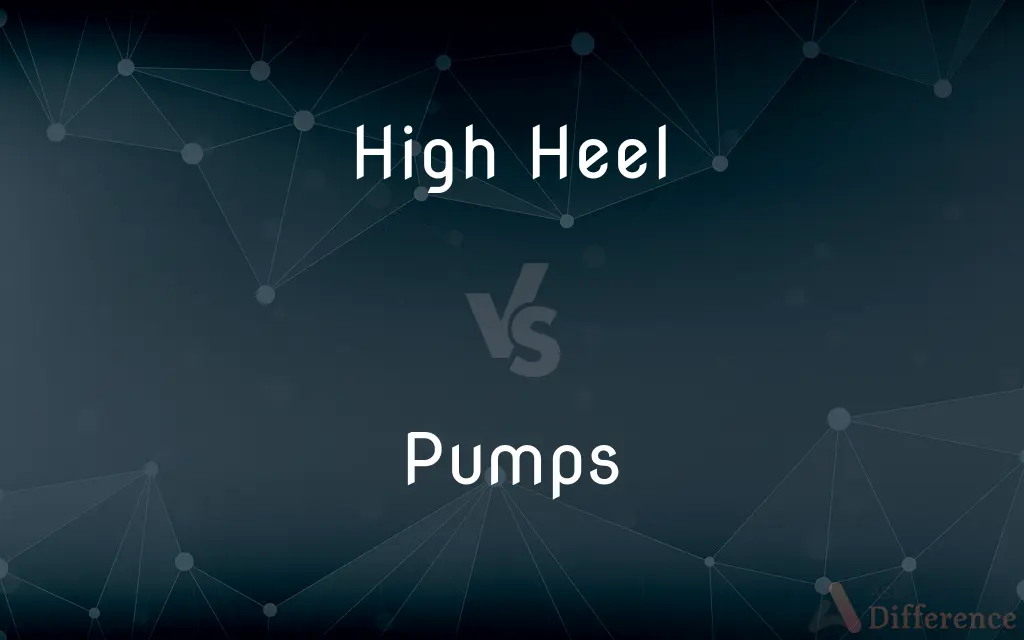High Heel vs. Pumps — What's the Difference?
By Tayyaba Rehman & Fiza Rafique — Published on February 10, 2024
High heels are shoes with elevated heels of varying styles and heights, while pumps are a specific type of high-heeled shoe with a low-cut front and usually without fastenings.

Difference Between High Heel and Pumps
Table of Contents
ADVERTISEMENT
Key Differences
High heels refer broadly to any shoe with an elevated heel, raising the heel higher than the toes. This category encompasses a wide range of styles, from stilettos to wedge heels. Pumps, on the other hand, are a specific type of high heel, characterized by a low-cut front, a closed back, and usually a seamless vamp without laces or buckles.
The heel height in high heels can vary greatly, from a modest lift to several inches, catering to different preferences and occasions. Pumps typically have a moderate heel height, making them a versatile choice for both professional and casual settings. The heel style in pumps is usually a stiletto or block heel, but always attached to the back of the shoe.
High heels can feature various design elements like straps, buckles, and decorative accents, offering a wide array of choices for different outfits and occasions. Pumps, in contrast, are known for their clean and classic design, often lacking embellishments, which contributes to their timeless appeal.
The choice between high heels and pumps often depends on the wearer's desired look and comfort level. High heels provide a diverse range of options to make a fashion statement, while pumps offer a balance of elegance and practicality, being a staple in many professional wardrobes.
In terms of comfort, high heels can vary; some might offer more support with additional straps or a wider heel, while others, like pointed stilettos, prioritize style over comfort. Pumps are generally considered more comfortable due to their lower heel height and supportive design, making them suitable for extended wear.
ADVERTISEMENT
Comparison Chart
Definition
Shoes with elevated heels.
A type of high-heeled shoe with a low-cut front.
Heel Height
Varies from low to very high.
Typically moderate.
Style Variations
Includes stilettos, wedges, etc.
Classic design, usually without fastenings.
Design Features
Can have straps, buckles, etc.
Often seamless with a clean look.
Typical Use
Fashion statements, formal wear.
Professional and everyday wear.
Compare with Definitions
High Heel
They elevate the wearer's heel significantly higher than the toes.
Walking in high heels requires practice and balance.
Pumps
Pumps are known for their seamless, elegant design.
She prefers pumps for their timeless style.
High Heel
High heels are shoes with raised heels of varying heights and styles.
She wore elegant high heels to complement her evening gown.
Pumps
They offer a versatile choice for various occasions.
Pumps are suitable for both office and evening wear.
High Heel
They vary in design from stilettos to chunky heels.
Her closet is full of high heels in every style imaginable.
Pumps
Pumps provide a balance of comfort and style.
For long workdays, she relies on her comfortable yet chic pumps.
High Heel
High heels often symbolize fashion and sophistication.
High heels are a popular choice for formal events.
Pumps
They typically feature a closed toe and heel.
Her red pumps matched perfectly with her dress.
High Heel
High heels can enhance posture and height.
She feels more confident and taller in her high heels.
Pumps
A machine or device for raising, compressing, or transferring fluids.
High Heel
Of footwear, having high heels.
Pumps
(Physiology)A molecular mechanism for the active transport of ions or molecules across a cell membrane.
High Heel
To walk in high heels.
Pumps
(Physics)Electromagnetic radiation used to raise atoms or molecules to a higher energy level.
Pumps
(Informal)The heart.
Pumps
(Informal)The place where consumers purchase gasoline. Used with the:gas prices rising at the pump.
Pumps
A shoe that has a closed back and is cut low around the toes, usually with heels and no fastenings.
Pumps
To cause to flow by means of a pump or pumplike organ or device:Derricks pumped oil out of the ground. The heart pumps blood throughout the body.
Pumps
To draw, deliver, or pour forth:a writer who pumped out a new novel every year.
Pumps
To propel, eject, or insert:pumped new life into the economy.
Pumps
To cause to move with an up-and-down or back-and-forth motion:a bicyclist pumping the pedals; a piston pumping a shaft.
Pumps
To push or pull (a brake or lever, for instance) rapidly:a driver pumping the brakes.
Pumps
To shoot (bullets, for example) at or into:a gunner pumping rounds at a target.
Pumps
(Physics)To raise (atoms or molecules) to a higher energy level by exposing them to electromagnetic radiation at a resonant frequency.
Pumps
(Physiology)To transport (ions or molecules) against a concentration gradient by the expenditure of chemically stored energy.
Pumps
To invest (money) repeatedly or persistently in something.
Pumps
To question closely or persistently:pump a witness for secret information.
Pumps
(Informal)To promote or publicize vigorously:The company pumped its new product on its website.
Pumps
To operate a pump.
Pumps
To move gas or liquid with a pump or a pumplike organ or device.
Pumps
To move up and down or back and forth in a vigorous manner:My legs were pumping as I ran up the stairs.
Pumps
To flow in spurts:Blood was pumping from the wound.
Pumps
(Sports)To fake a throw, pass, or shot by moving the arm or arms without releasing the ball.
Pumps
Plural of pump
Pumps
A low-cut shoe without fastenings
Pumps
Pumps are a classic type of high-heeled shoe with a low-cut front.
She chose black pumps for her business meeting.
Common Curiosities
Can all high heels be considered pumps?
No, not all high heels are pumps. Pumps are a specific style of high-heeled shoe.
Are pumps always high-heeled?
No, pumps can have various heel heights, including low, medium, and high.
What's the typical heel height for high heels?
High heels typically have a heel height of 2 inches or more.
Can high heels be comfortable?
Comfort depends on the design, fit, and individual preference. Some high heels are designed for more comfort than others.
How do I choose the right size for pumps?
Choose a size that fits snugly but comfortably, considering foot length, width, and any specific brand sizing.
Do men wear high heels or pumps?
While traditionally worn by women, men can and do wear high heels and pumps as well.
What are high heels?
High heels are shoes that raise the heel of the wearer's foot significantly higher than the toes.
What are pumps?
Pumps are a type of shoe with a low-cut front, a heel, and no fastenings.
Are pumps suitable for formal occasions?
Yes, pumps can be very suitable for formal occasions, especially when designed with elegant materials or embellishments.
Can pumps be worn with casual outfits?
Yes, pumps can be styled with casual outfits, especially when they have a lower heel or simpler design.
Are pumps considered professional wear?
Yes, pumps are often considered professional wear, especially those with a moderate heel.
Are high heels bad for your feet?
Wearing high heels for extended periods can lead to discomfort or foot problems. It's important to balance wear with proper foot care.
How can I make high heels more comfortable?
Using insoles, choosing the right fit, and opting for heels with supportive features can improve comfort.
What materials are used for high heels?
High heels can be made from various materials, including leather, suede, fabric, and synthetic materials.
What is the best way to maintain high heels?
Maintain high heels by cleaning them regularly, storing them properly, and repairing heels or soles as needed.
Share Your Discovery

Previous Comparison
Internal Fragmentation vs. External Fragmentation
Next Comparison
Scotch vs. BeerAuthor Spotlight
Written by
Tayyaba RehmanTayyaba Rehman is a distinguished writer, currently serving as a primary contributor to askdifference.com. As a researcher in semantics and etymology, Tayyaba's passion for the complexity of languages and their distinctions has found a perfect home on the platform. Tayyaba delves into the intricacies of language, distinguishing between commonly confused words and phrases, thereby providing clarity for readers worldwide.
Co-written by
Fiza RafiqueFiza Rafique is a skilled content writer at AskDifference.com, where she meticulously refines and enhances written pieces. Drawing from her vast editorial expertise, Fiza ensures clarity, accuracy, and precision in every article. Passionate about language, she continually seeks to elevate the quality of content for readers worldwide.
















































